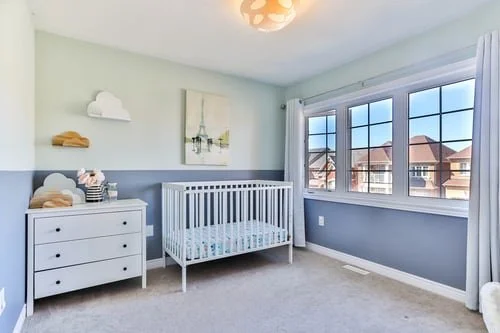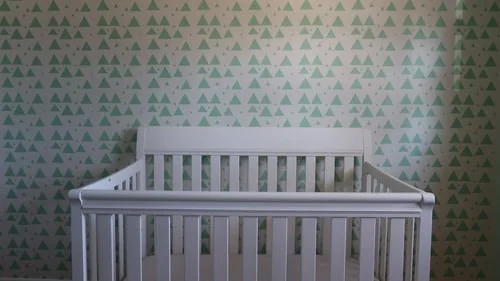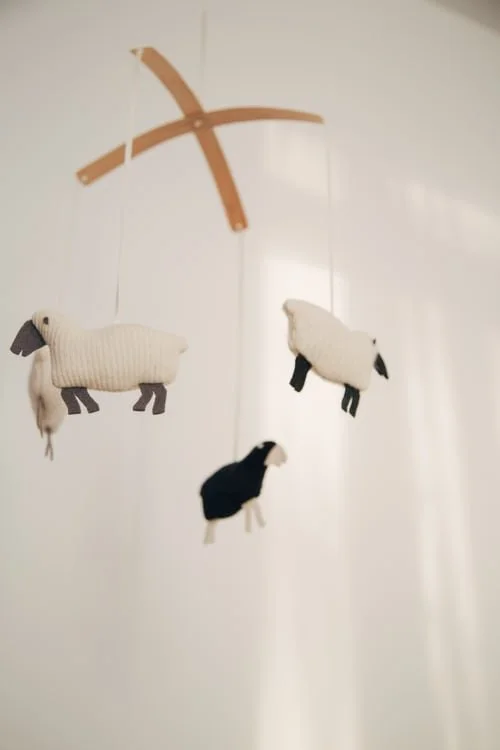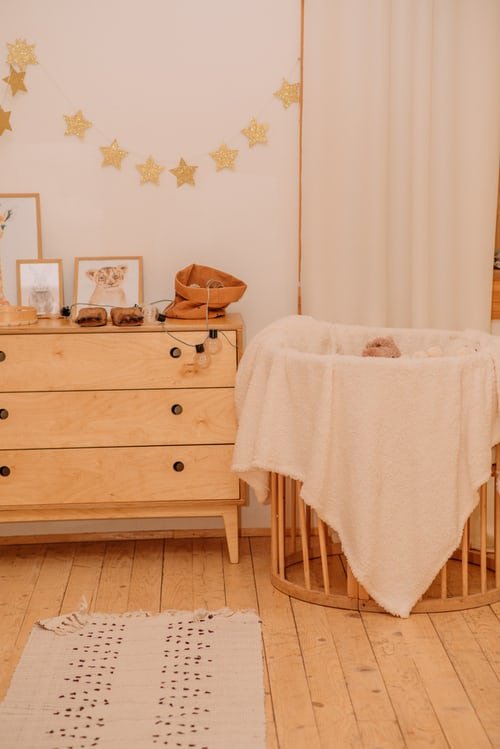
A resource for those seeking information on organizing and transforming spaces.
Useful Tips for Decorating a Nursery
If you're expecting your first bundle of joy, decorating a nursery may seem like the biggest challenge so far. Should you start by painting the walls or looking into furniture? Maybe you should come up with a theme first? All of those questions will overwhelm you quickly, so stop thinking and check out our tips for decorating a nursery. We have all the useful tips in one place, ready to make your baby preparations a breeze.
If you're expecting your first bundle of joy, decorating a nursery may seem like the biggest challenge so far. Should you start by painting the walls or looking into furniture? Maybe you should come up with a theme first? All of those questions will overwhelm you quickly, so stop thinking and check out our tips for decorating a nursery. We have all the useful tips in one place, ready to make your baby preparations a breeze.
Find a color scheme
The first thing to consider when decorating a nursery is the colors. From the color of the walls to the furniture, carpets, and accessories, you'll need a color scheme to keep your room look cohesive. Neutral colors like beige, white, light grey and yellow are always the best choices because they allow plenty of diversity. On top of that, once the baby is older and ready to move to another room, you can easily adapt the room into an office or a den without needing to change the color of the walls. However, if you plan to update the nursery into a kid’s room when the child is older, then you can feel free to choose a gender-specific color such as pink, green, blue or purple.
Buy furniture first
Once you’ve chosen the color for the room, it’s time to start looking at furniture pieces. From the crib for the baby to have sweet dreams to the dressing table where you’ll keep all the supplies and a rocker chair to keep you comfy, you'll need a whole set of furniture items to fill your baby's room. After you've put together the crib and the rest of the big items, you will have a starting point perfectly visualized to help you move on with the décor.
Add toys and décor
As the baby grows, he or she will need the entertainment to keep them occupied. Whether during mealtime or when you need them not to fuss, popular infant toys will be your baby’s best friends offering all the fun they need. Therefore, make sure you stock the room with infant toys such as chewy fidgets, plushies, or weighted animals. Patterned throw pillows will be a lovely addition to a nursery. It's a budget-friendly option that will add interest to the room and make you cozy as well, while you feed the baby or put them to sleep.
Consider a theme
Another way to decorate a pleasant nursery is to incorporate a theme into the décor. How about you create a heavenly angelic ambience with a mixture of baby blue and white, clouds, fluff, and plush? Maybe you'd like your princess to feel like she's in her own castle with a canopy over the crib, light pink walls, glitter and rainbows on the walls? Are you a nature lover? Consider mixing brown, green and yellow for a jungle-like theme that will offer both the calmness of the woods and excitement of the wilderness to the interior.
Consider quality lighting
Lighting is crucial for an enjoyable ambience. That's why you'll want to allow for plenty of daylight but also make sure you can block it maximally. Install heavy curtains and quality blinds to offer your baby an optimal sleeping environment during their first days at home. Newborns tend to sleep a lot and sometimes throughout the day, so you'll need to make sure the lighting is adequate throughout the day and night. Invest in soothing night lights to create a gentle night-time glow in the nursery.
Getting your home ready for the baby will be emotional and somewhat challenging but it will also bring immense joy. Make sure everything is set at least a month before your due date because you never know when the little one will decide to come to this world. Pick a theme, decide on colors and look for quality furniture to create the best baby nook for your bundle of joy.
Great Outdoors: Interior Design for Exterior Spaces
Here are some tips to achieve superb design to outdoor spaces:
As the temperature rises during the summer, people's usual response is to go to outdoor spaces. The smell of barbecues in the backyard and the blooming flowers lure them out to the patio or porch with family and friends. During these months, you would want to have a good design for our outdoor spaces like rooftop gardens, courtyards, dining terraces, patios, and pool decks.
One of the fun aspects when designing outdoor spaces is that you can pop up any color you prefer. It is one spot where you can freely go bold in its architecture-pleasing design. It also works well with whimsical touches like a quirky garden statue or a dragonfly pattern.
Following those basic design principles is essential to create enticing and attractive outdoor spaces that people can access and use comfortably. The finishes, lighting, accessory, furniture, and utility options for these outdoor spaces are continually evolving and expanding, allowing you to have a wider variety and creative approaches.
Here are some tips to achieve superb design to outdoor spaces:
Furniture Fundamentals
Most outdoor spaces have hard edges and furniture materials that most people will avoid. However, people would prefer to sit in those pieces of furniture that can make them comfortable, just like indoors. Likewise, it is also important not to go for those opposite oversized puffy cushions that are likely not to last when exposed to outside elements. Those extreme oversized cushioning will also create undesirable excess warmth during hot or humid climates.
Outdoor sling chairs are an excellent comfort option and easy to maintain. Some best outdoor furniture options include wrought iron, aluminum, and wood-like plastic materials that are wearing better than natural wood. Furniture made from fresh resins and recycled plastic is also a great option as these materials are hard to crack, peel or fade, resistant to mildew, stains, and moisture, and highly durable.
Universal Designs
It is essential to consider universal design principles, especially for commercial applications. Most people find that chairs with arms are easier to exit, and at the same time, a less than 100 degrees back recline of the seat usually is comfortable to people of all ages.
When outdoor spaces apply the universal design principle, everyone enjoys it the same way. These designs cater comfortably to everyone and have no differences due to age or size. Its aesthetic design and access are all interwoven, and anyone feels welcome.
Finishing Touches
Whenever possible, it is an excellent option to incorporate a water feature or fireplace as a highlight in the outdoor spaces. There are many options of water fountains, and fire pits, or fireplaces, including its fuel alternative to wood.
One of the significant considerations of water features is maintenance, as when a water fountain or wall gets dirty, it can become an eye-catcher and turn into an eyesore.
Outdoor lighting is a must to live up to every outdoor space to its full potential. Lighting is a valuable tool and an essential requirement for security and safety and creating a moody atmosphere. However, installing exterior access doors and panels would be best to conceal those outdoor wiring connections safely and adequately. They also prevent them from outside elements and unauthorized access.
Choosing the Right Fabric
When considering using fabrics in outdoor spaces, it requires careful consideration when choosing the right style and quality as it deals with outside elements. Another thing to consider is how smoothly and efficiently the air can pass through the fabric. These considerations are essential to prevent mildew and mold as they can become an eyesore to people and affect anyone's comfort.
Generally, the water-resistant fabric is an excellent idea. But it has some issues and often trade-offs in its breathability since the more water-resistant the fabric, the more it tends not to let air pass through. However, water-resistant and UV-resistant material is a top priority option on umbrellas and awnings as it is essential for all exterior shading applications. It is necessary to note that all materials and accessories in outdoor spaces require regular cleaning and maintenance to maintain their aesthetic and function.
Landscape Meets Interior Themes
Flowers and plants are natural choices as outdoor accessories of varying color, foliage, and heights can make a statement and influence visual interest. Consider the theme established in the interior surfaces in designing outdoor spaces. The continuity of the design and themes from indoor to outdoor spaces are essential and should have similarities to their characters to make them more inviting. A simple, striking sculpture, water feature, streamlined furnishings, and showcase of carefully chosen plants and flowers are necessary and work well in a contemporary exterior style design.
Exterior living spaces are therapeutic simply because, in nature, being outdoors makes us feel more relaxed, reducing stress levels. Psychologically, when we spend time outside, it relieves anxiety and depression, promotes good vision, acts as our sanctuary, and improves our immune system to get away and feel relaxed from those everyday life stressors.
So when designing outdoor living spaces, it is essential to follow the principles of universal design, especially in commercial outdoor areas, to create incredible scenes and ensure comfort to all occupants.
Eco-Friendly Roof Hatches: Pros and Cons
Sustainability is a significant driving force for the modern construction industry. It is the focus of many innovators as more people become increasingly aware of our impact on the environment. As a result, new materials and industry practices continually revolutionize how the construction industry operates.
Sustainability is a significant driving force for the modern construction industry. It is the focus of many innovators as more people become increasingly aware of our impact on the environment. As a result, new materials and industry practices continually revolutionize how the construction industry operates.
Hatches may come in various sizes, forms, and customizable designs to satisfy individual requirements and give easy roof access. Many roof hatch designs are available in multiple materials, including aluminum, galvanized steel, stainless steel, or a mix of aluminum and steel. These energy-efficient roof hatches can provide adequate thermal insulation to keep the heat inside during the winter and the cool outside during the summer.
It is essential to have roof hatches installed for easy and safe access to the area for maintenance. Most modern buildings require these installations for regular tasks and other reasons like natural lighting. Due to the influence of the current sustainability trend, a roof hatch must be environmentally friendly to meet the market demand.
These pros and cons of eco-friendly roof hatches may help you understand more about their good and bad sides:
Pros
1. Utilized as ventilation
There are variations of roof hatches that serve as ventilation to facilities that handle heat or hazardous particulates, such as factories that handle oil production. They require these installations to prevent dangerous materials from accumulating, potentially damaging the interiors of the building.
Some hatches provide a heat escape in case of fire. It prevents the build-up of heat that may warm the insides of the building, increasing the chances of other flammable materials combusting due to the fire. It also allows smoke to leave the building, allowing firefighters to enter and resolve the issue.
2. Provides easy access to the roof area
The roof hatch's primary function is to provide entry to the roof area during maintenance and installation. Regular inspection of the site, transportation, and installation of HVAC and other equipment are some of the tasks performed by personnel to maintain the overall operation of the building.
Occupants of the building can also use it to access the roof area for recreational purposes. If the space is a green roof, the hatch will give a safe way for people to enter the site. It is an excellent way for them to gather and de-stress within the space of this green roof.
3. Allows natural light into the building
There are variations of roof hatches that function as an entryway for natural light to enter the interior space. Most of these roof hatch's composition is glass, allowing sunlight to enter. It helps regulate temperature, especially during the winter months, cutting down power costs.
4. It is an energy-efficient way to regulate temperature
Thermally broken access hatches are the best example of roof hatches that help with controlling heat and coolness. It creates a barrier between the outside and inside temperatures to protect the consistency of the indoor temperature by not letting the heat escape.
5. Made from sustainable materials
The primary materials utilized for roof hatches are metals. Metals are recyclable and robust, making them a widely used material across many sectors but specifically in the construction industry, where their utilization is almost necessary. With this material's recyclable and robust nature, people consider it sustainable.
Cons
1. Possible fall hazard
OSHA set regulations specifically for roof access hatches because they pose a potential fall hazard if unsupervised and left open. To counter this danger, a roof hatch of significant size must have some safety railings around it to prevent people from accidentally falling. The personnel in charge must also properly close the hatches when not in use.
2. Possible security risks
Materials can deteriorate and get damaged as time passes. Roof hatches are susceptible to this vulnerability when not adequately maintained or replaced. Despite the level of protection that some roof hatches grant, they may still pose a security risk, such as unauthorized access.
If the roof hatch is in a state of degradation and not maintained to perform its function, burglars could use it as an entry point to enter the establishment.
3. Improper installation leads to poor heat regulation
Some roof hatches have a thermal break feature that allows them to protect the indoor temperature of the building. Improper installation could lead to heat escaping unintentionally, which will affect the thermal regulation of the building.
Ensure that the ones installing the roof hatches have proper credentials to avoid such incidence. Building managers should also schedule a regular inspection to check their functions because it might drive up the power cost of the building.
4. Possible leak source
Since the roof hatch is an entry point, if it does not have proper sealing or is not closed correctly during rainfall or snow, it will become an entry point for water inside the building. Ensuring that all gaps or holes get properly sealed is paramount to the integrity of the structure and operation of the entire establishment.
Takeaway
Creating something sustainable and long-lasting is a dream for the construction industry. As green and sustainable building projects progress, we can see more material production aimed towards such purposes. Roof hatches will be an indispensable asset for future projects. Consult a licensed professional that you trust for more information.
Guest Post - 10 Tips for Being Productive When Working From Home
One of the most difficult, yet satisfying challenges in the home organization is working remotely from home. It's something frustrated clients often ask us to solve. You'll be amazed at how much more productive you can be if your workspace and family responsibilities are clearly defined. Our tips should soon help you start improving your home-based work life.
One of the most difficult, yet satisfying challenges in the home organization is working remotely from home. It's something frustrated clients often ask us to solve. You'll be amazed at how much more productive you can be if your workspace and family responsibilities are clearly defined. Our tips should soon help you start improving your home-based work life.
1. Home Office
Having a designated workspace is a priority. It makes your working day feel more official. If you don't have a small room to spare, choose a space that's in the quietest part of the house. A folding screen placed around your desk area gives you more privacy. Install a desk or table, shelving and a comfortable office-style chair. Check you have enough electrical sockets for equipment such as a printer and desk lamp.
2. Lines of Communication
It's important to get an efficient IP phone system installed from the beginning. It's vital for connecting to all your devices and every other company employee. You'll instantly appear more competent if you have an integral phone system that includes voice mail, video-conferencing and high-quality audio. Some include sophisticated headsets with useful noise-cancelling features.
3. Organize Schedules
Some people find they are more productive if they keep to regular working hours. Try maintaining the discipline of office life and make sure you begin at the same time each day. Insist your family cooperate and respect your working schedule. Encourage them to wait until you finish your tasks before discussing school projects or what to have for dinner.
4. Avoid Online Distractions
Without a boss supervising your work activities, it's easy to become distracted by everything online. Make sure your PC's home page has no quick links to news channels, fun games and favorite social media sites you might visit in your leisure hours. Leave your smartphone out of reach and only peek at e-mails at designated intervals.
5. List Tasks
Some people have adapted too well to working remotely from home. They ignore lunch breaks and often work well into the night. You need to be organized to prevent overloading any working day. Assess the work you have and sort out a list of daily tasks. Prioritize urgent assignments. Intersperse difficult projects with easier work to bring variety into your schedule.
6. Accommodating Family Life
Working from home leaves you vulnerable to all kinds of family distractions. Kids off school, your devoted life partner with time away from work or your dearest relatives visiting unannounced, they're all incredibly intrusive. Plan and organize emergency childcare and always tell relatives to fix visiting times. Encourage your partner to take kids out on visits to museums or the local park.
7. Regular Breaks
It's surprising how your concentration can become hazy unless you regularly refresh your brain cells. Target short breaks plus a long time for relaxing halfway through the day. Take a brief walk around the block or do a few exercises to improve concentration. And did you know the stimulating effects of drinking tea can actually last much longer than coffee?
8. Organize Healthy Meals
Use your spare time to cook and freeze multiple portions of healthy snacks and meals. They'll be convenient when your family needs a quick lunch break without interrupting your work. Cooking a nourishing family meal after you've finished working can be relaxing and help you de-stress. Make it a special time of day where you can all enjoy talking over the day's events.
9. Time Management
Working at home leaves you to organize your time effectively. Without supervision, it's easy to take too long on an assignment. Consider how long a task should take and set an alarm clock to keep you on track. Competing with the clock to finish before it rings can help your productivity level increase. Alternatively, a low volume, background commentary from a local radio station should provide plenty of time checks.
10. Flexible Attitude
It makes a great difference if you choose to work from home rather than being forced into it. Successful home workers usually evolve flexible routines that are tailored to their particular way of life. You are free to work at odd hours such as a very early morning or late at night. Experiment and find out which parts of your day appear the most productive. You could even have intervals of a few hours where you can include family responsibilities and household chores with ease.
Conclusion
Working remotely often depends on your mindset. But adopting a disciplined, yet flexible approach can help you become super organized. Find your perfect space for a home office, install the best equipment and be strict about needless interruptions from your loved ones. You might not get everything right at once, but with a little practice, you're sure to be more productive in the long run.
Author Bio: This article was written by Seamus Dunne of Conversation Piece. Conversation Piece is a leading player in telecommunications, providing VoIP Phone Systems nationwide to large and small-scale businesses.













